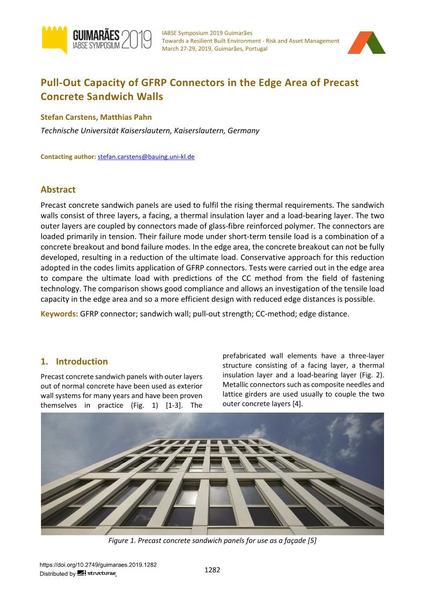Pull-Out Capacity of GFRP Connectors in the Edge Area of Precast Concrete Sandwich Walls

|
|
|||||||||||
Détails bibliographiques
| Auteur(s): |
Stefan Carstens
(Technische Universität Kaiserslautern, Kaiserslautern, Germany)
Matthias Pahn (Technische Universität Kaiserslautern, Kaiserslautern, Germany) |
||||
|---|---|---|---|---|---|
| Médium: | papier de conférence | ||||
| Langue(s): | anglais | ||||
| Conférence: | IABSE Symposium: Towards a Resilient Built Environment Risk and Asset Management, Guimarães, Portugal, 27-29 March 2019 | ||||
| Publié dans: | IABSE Symposium Guimarães 2019 | ||||
|
|||||
| Page(s): | 1282-1288 | ||||
| Nombre total de pages (du PDF): | 7 | ||||
| DOI: | 10.2749/guimaraes.2019.1282 | ||||
| Abstrait: |
Precast concrete sandwich panels are used to fulfil the rising thermal requirements. The sandwich walls consist of three layers, a facing, a thermal insulation layer and a load-bearing layer. The two outer layers are coupled by connectors made of glass-fibre reinforced polymer. The connectors are loaded primarily in tension. Their failure mode under short-term tensile load is a combination of a concrete breakout and bond failure modes. In the edge area, the concrete breakout can not be fully developed, resulting in a reduction of the ultimate load. Conservative approach for this reduction adopted in the codes limits application of GFRP connectors. Tests were carried out in the edge area to compare the ultimate load with predictions of the CC method from the field of fastening technology. The comparison shows good compliance and allows an investigation of the tensile load capacity in the edge area and so a more efficient design with reduced edge distances is possible. |
||||
